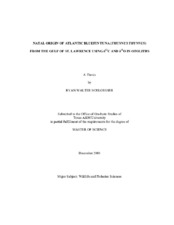| dc.contributor.advisor | Rooker, Jay R. | |
| dc.creator | Schloesser, Ryan Walter | |
| dc.date.accessioned | 2010-01-16T01:30:03Z | |
| dc.date.accessioned | 2010-01-15T00:05:19Z | |
| dc.date.available | 2010-01-15T00:05:19Z | |
| dc.date.available | 2010-01-16T01:30:03Z | |
| dc.date.created | 2008-12 | |
| dc.date.issued | 2009-05-15 | |
| dc.identifier.uri | https://hdl.handle.net/1969.1/ETD-TAMU-3265 | |
| dc.description.abstract | Increased knowledge of stock mixing and migration patterns of Atlantic bluefin tuna (Thunnus thynnus) is required to appropriately manage and conserve declining populations. The nursery origin of giant bluefin tuna present in the Gulf of St. Lawrence was identified using stable carbon (δ13C) and oxygen (δ18O) isotopes in sagittal otoliths. Anthropogenic and natural processes are capable of impacting atmospheric and oceanic concentrations of δ13C and δ18O, affecting otolith concentrations. Therefore, inter-decadal variation of δ13C and δ18O in the otolith cores (corresponding to the first year of life) of bluefin tuna was examined prior to stock predictions and temporal variability was detected in both isotope ratios. Significant changes in both δ13C and δ18O were recorded in the otolith cores of individuals with birthdates between 1947 and 2003. Both δ13C and δ18O varied significantly as a function of year of birth, with δ13C decreasing and δ18O increasing over the time period investigated (-2.39×10-2 and 5.78×10-3 per year, respectively). The rate of change in otolith δ13C was nearly identical to the reported rates of atmospheric δ13C depletion, recently attributed to the burning of fossil fuels (referred to as the Suess effect). Observed shifts in otolith δ18O were less pronounced and likely linked to changing physicochemical conditions (i.e. salinity) in oceanic reservoirs over the time period investigated. The results show that otolith cores of bluefin tuna effectively track inter-decadal trends and record past oceanic δ13C and δ18O levels. After adjusting for inter-decadal trends, the isotopic composition of milled otolith cores of giants from three decades (1970s, 1980s, 2000s) and three regions were compared to otolith δ13C and δ18O values of yearling bluefin tuna collected from eastern and western nurseries. Maximum likelihood estimates indicated that 99% of bluefin tuna caught in the Gulf of St. Lawrence fishery originated from the western nursery, with no significant differences among the decades and regions examined. Results suggest that little to no mixing of eastern and western populations of adult bluefin tuna occurs in the Gulf of St. Lawrence, making it important for the management and conservation of the declining western population. | en |
| dc.format.medium | electronic | en |
| dc.format.mimetype | application/pdf | |
| dc.language.iso | en_US | |
| dc.subject | stock structure | en |
| dc.subject | natal origin | en |
| dc.subject | population mixing | en |
| dc.subject | otolith chemistry | en |
| dc.subject | suess effect | en |
| dc.subject | Stable isotopes | en |
| dc.title | Natal origin of atlantic bluefin tuna (thunnus thynnus) from the gulf of st. lawrence using δ13c and δ18o in otoliths | en |
| dc.type | Book | en |
| dc.type | Thesis | en |
| thesis.degree.department | Wildlife and Fisheries Sciences | en |
| thesis.degree.discipline | Wildlife and Fisheries Sciences | en |
| thesis.degree.grantor | Texas A&M University | en |
| thesis.degree.name | Master of Science | en |
| thesis.degree.level | Masters | en |
| dc.contributor.committeeMember | Louchouarn, Patrick | |
| dc.contributor.committeeMember | Alvarado Bremer, Jaime R. | |
| dc.type.genre | Electronic Thesis | en |
| dc.type.material | text | en |
| dc.format.digitalOrigin | born digital | en |


